In the treeless prairie, many birds resort to nesting on the ground, hidden among tufts of grass or buried under bushy shrubs. The western meadowlark is one such bird, and one of my favourites to photograph in the spring, when its cheerful flute-like song bubbles across the prairie. By the early 1990s, I had often photographed meadowlarks but I had never found one of their nests. On a May 1995 trip to the badlands of Dinosaur Provincial Park, my luck finally changed. As I trekked across the prairie, a meadowlark flew up in front of me, carrying a tiny white blob in its beak. Aha! Now I had it. The blob was a faecal sac. Young meadowlarks, as well as most other young songbirds, excrete their faeces in compact little packages surrounded by a gelatinous membrane, which the parents carry away from the nest to discard. I knew that, the meadowlark knew that, but the meadowlark didn’t know that I knew that. I quickly found the hidden nest, tucked at the end of a 20-centimetre-long (8-in.) tunnel of grass. Five naked, little, gaping gargoyles clustered inside. I wanted a photograph of the chicks, but I wanted it later when they would be larger and fuzzy-headed, so I hiked back to the nest a week later. When I first gazed down the tunnel of grass I couldn’t see any of the nestlings. My first thought was that the nest had been predated. Skunks, coyotes, red foxes, magpies and crows locate many of these nests and gobble up the nestlings. I felt sick, and for an instant, I blamed myself for the loss, believing that perhaps my scent had attracted a predator. I parted the grass for a closer look, and froze in fear. The head of a large prairie rattlesnake was poised on the edge of the nest, centimetres from my hand. The snake’s body was noticeably swollen with distinct bulges. It had probably swallowed the entire family of fuzzies without wasting a single drop of venom. I thought, if a snake can smile, this one has a good reason to do that.
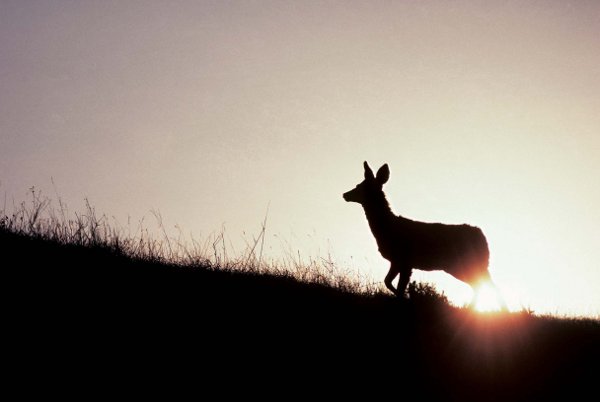
A femaile mule deer silhouetted against the Alberta sky
Many people believe that French fur traders were the first to coin the name badlands. They described the rugged topography as mauvaises terres, possibly because the land was difficult to traverse. The name could have also arisen out of the frustration of settlers who found the rocky badlands impossible to farm. Whichever you believe, the badlands are still only bad from the viewpoint of humankind. Tucked within the prairies, the badlands are a unique environment, rich in wildlife and one of my favourite prairie haunts. In the badlands, I like to drift and wander, for to introduce a pace or a purpose would lessen the experience. I am drawn to the badlands by their grandeur. A grandeur that humbles me, and fills me with a comforting sense of insignificance.
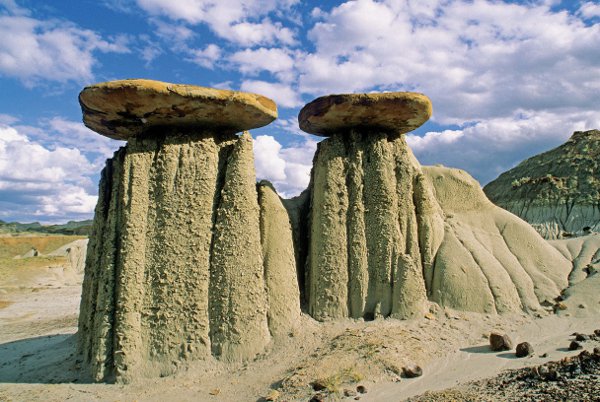
The hoodoos, formed by eons of erosion
Badlands stretch along many rivers in the prairie regions of Saskatchewan and Alberta, but the most spectacular are those that shoulder the shores of the Red Deer River where it cuts through Dinosaur Provincial Park in southern Alberta. Here, a visitor is immersed in a moonscape of gullies, pinnacles, mounds and flat-topped mesas that have been sculpted and worked by millennia of hot dry summers and long, cold winters. The badlands of Dinosaur Provincial Park boast a terrain like no other, and in 1979 the United Nations Educational, Scientific and Cultural Organization (UNESCO) designated the park as a World Heritage Site. In so doing, Dinosaur Provincial Park joined the ranks of such globally significant areas as the Serengeti Plains of East Africa, Ecuador’s Galapagos Islands and Australia’s Great Barrier Reef.
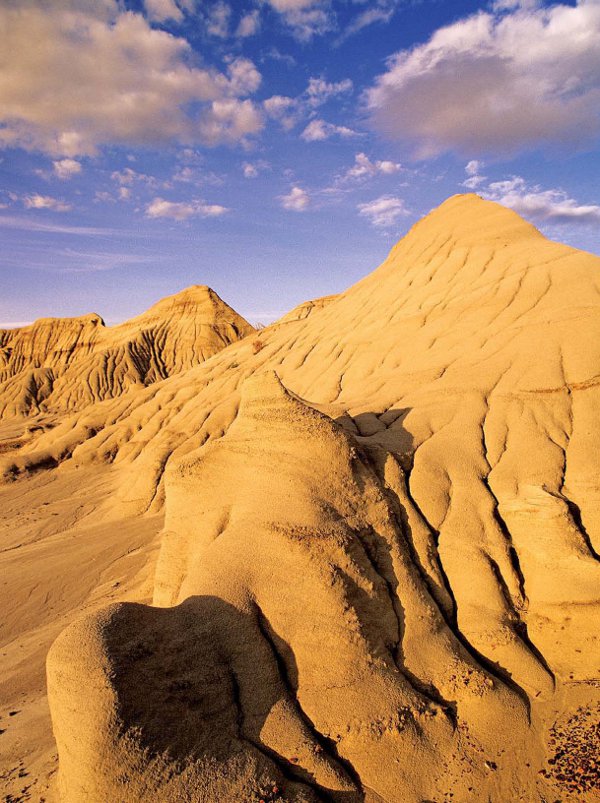
Eroded badland slopes
Dinosaur Provincial Park has one of the highest densities of nesting birds of prey in Canada. Here golden eagles and ferruginous hawks (a threatened species in Canada) build their large stick nests on remote badland slopes or inaccessible cliff ledges. Merlins (medium-size falcons) choose the groves of cottonwoods that grow along the Red Deer River, while prairie falcons, kestrels and great horned owls find nesting sites in cavities and caves eroded high up in the bedrock.
The caves and crevices that permeate the badland’s bedrock benefit many animals besides the birds of prey. Within the park, extensive subterranean, water-eroded channels lie hidden beneath the smooth contours of the slopes. The ceilings of these channels are fragile and can suddenly collapse if you walk over them. When they do, a sinkhole results. One park ranger recalled a time when he looked into a sinkhole and a bobcat leaped out and bolted away. The cavities are also used by long-tailed weasels, striped skunks, coyotes and Nuttall’s cottontails as hideaways and birthing chambers. Badland cavities are also used by snakes. All snakes in Canada must hibernate in winter to keep from freezing. They den in cavities deep below the frostline. Garter snakes, bullsnakes, and prairie rattlesnakes may hibernate together in the same underground cavity.
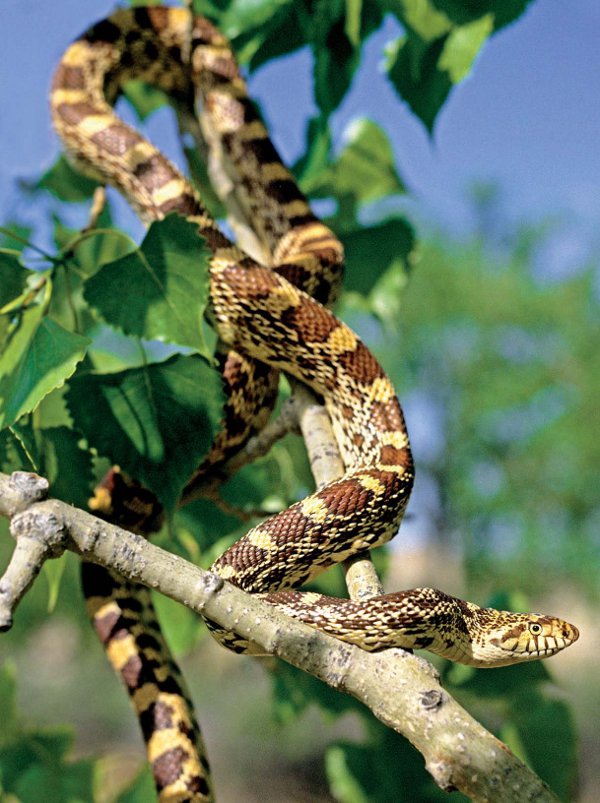
A bullsnake climbs a cottonwood tree, possibly searching for nesting birds
Dinosaur Provincial Park is best known for its dinosaur fossils. The park is a 70-million- year-old bonebed of tremendous importance. To date, paleontologists have identified 35 different species of dinosaurs, and the slopes of the badlands continue to yield surprises as new species are unearthed by erosion every year.
I have photographed the park in every season and there are subjects to challenge almost every photographer. For those who like landscapes there are the sensuous curves of hoodoos, the slow meander of the Red Deer River flanked by forests of cottonwoods, and the graphic beauty of erosion channels. Add sunshine and snow to the mix and you have a wonderful blend of highlights and deep blue shadows under an azure sky. For macro lovers there are butterflies, spiders, and beetles, as well as crimson and golden cactuses, the bobbing heads of purple crocuses, and a range of delicate blooms in almost every shade of yellow. For those whose interests lie with avian subjects the park boasts a bird list with over 150 species. Besides the meadowlarks I mentioned above, there are mountain bluebirds whose feathers glint like burnished sapphires, handsome spotted towhees, yellow-breasted chats, high-flying nighthawks, and majestic eagles and falcons to name just a few. For shutterbugs who like to focus on creatures of the furry kind there are jackrabbits, cottontails, coyotes, mule deer and white-tailed deer.
The namesakes of Dinosaur Provincial Park have long disappeared, but you can still feel the rush of the wind up a steep-sided coulee, you can still smell the aroma of summer- warmed sage, and you can still watch a mule deer buck atop a butte, its profile ablaze against the setting sun. If you dream only of the past, you will never discover the present. The badlands are waiting.
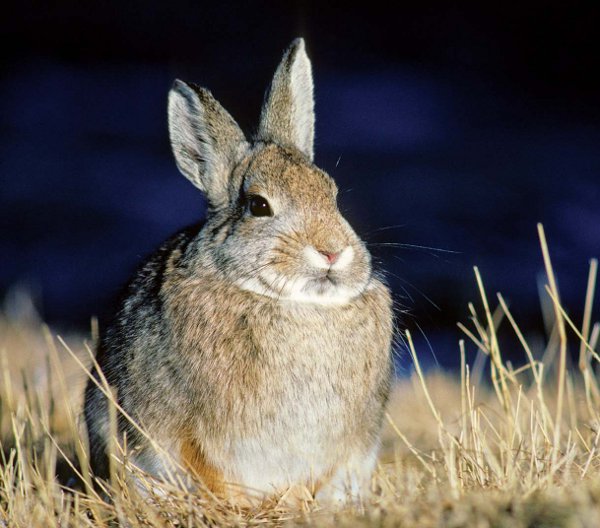
Nuttall's cottontail
article by Wayne Lynch
| PHOTONews on Facebook | PHOTONews on Twitter |







